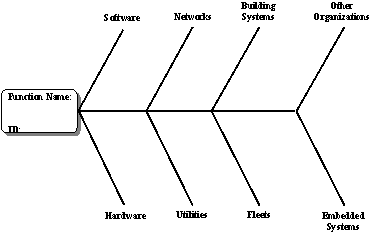Common menu bar links
Breadcrumb Trail
Institutional links
Chief Information Officer Branch
IT Project Review and Oversight
Enhanced Management Framework
ARCHIVED - A Guide to Effective Business Continuity in Support of the Year 2000 Challenge
 This page has been archived.
This page has been archived.
Archived Content
Information identified as archived on the Web is for reference, research or recordkeeping purposes. It has not been altered or updated after the date of archiving. Web pages that are archived on the Web are not subject to the Government of Canada Web Standards. As per the Communications Policy of the Government of Canada, you can request alternate formats on the "Contact Us" page.
Appendix F - Asset Mapping Approach
1. How to Map Assets to Business Functions
In order to clearly link the asset conversion work to the business continuity activities, departments must map their Year 2000 assets to each function. This mapping provides a more detailed understanding of the relationship between risks related to the asset conversion work and the business risks and related impacts.
2. Map Assets to Business Functions
2.1 Process
The objective of this process is to map assets to the specific function they are supporting. Categories of assets should be developed in order to facilitate the mapping process. Recommended categories include:
- Software (includes third party vendor software, operating systems, applications, etc.);
- Networks (includes all equipment between the communication card on the end-terminals – LAN, MAN, WAN, PBX - including private switching equipment but excluding processing units such as PC's, servers, mainframes);
- Real property systems (includes electrical supply, security, climate control, elevators and other systems);
- Other organizations (includes other governments, departments, or organizations including these organizations that are part of the supply chain of the departments as well as the procurement and legal organizations);
- Hardware (includes processing units such as PC's, servers, mainframes);
- Utilities (includes electricity, telephone, mail service, etc.);
- Fleets (includes aircraft, ships, automobiles, etc.); and
- Embedded systems (includes manufacturing and process control; transportation and navigation equipment such as airplanes, trains, marine, traffic lights, air traffic control, etc.; office systems and mobile equipment such as faxes, copiers, videos, televisions, cell phones etc.; medical devices such as pacemakers, monitoring systems, x-rays, etc.; lab equipment).
2.2 Deliverable
The deliverable to be produced as part of this process is a "cause-and-effect" diagram as shown below. Using the cause-and-effect relationship between assets and business functions, departments can link their conversion activities to the business function they support. A sample "cause-and-effect" diagram, using the above categories, is provided below.

Figure F-1 – "Cause-and-effect" diagram
3. Document Asset Mappings
3.1 Process
The objective of this process is to document, in a clear and concise, fashion the results of the asset mapping exercise done using the "cause-and-effect" diagrams described in Section 2 above.
3.2 Deliverable
The deliverable to be developed as part of this activity is a table that identifies:
- The name of the function;
- The owner of the business function (including the phone number); and
- The assets identified within each of the categories (Software, networks, building systems, other organizations, hardware, utilities, fleets, and embedded systems).
4. Techniques and Tools
This table provides a summary of the techniques and tools used for this process. Details of the techniques and tools can be found in the appendices or the referenced documents.
Table F-1: Asset Mapping Techniques and Tools
|
Activity |
Techniques and Tools |
|---|---|
| Map Assets to Business Functions | Cause-and-effect Analysis [CRM Guidebook, Chapter A-8, Page 301]. |
| Document Asset Mappings | A sample asset mapping table is provided in Section F-1 of this Appendix. |
5. Guidelines and Tips
The following are guidelines and tips that can facilitate the performance of this activity:
- Let function owners do the first mapping, use groups including technical individuals to validate the "cause-and-effect" diagrams produced by the function owners;
- Focus on coverage first (identify as many as possible), refine as conversion progresses; and
- Identify asset owners or asset category owners. Assets owners are often those individuals that will likely be tasked to oversee the conversion of these assets.
Section F-1: Sample Asset Mapping Table
The following asset mapping table is provided as an example only. It depicts the asset categories from Figure F-1 as column headings, and contains detailed assets for a specific business function.
Table F-2: Sample Asset Mapping Table
| ID: 5.1.2 | |||
|---|---|---|---|
| Function Name: Detection of distress alerts ("function owner") | |||
| Software | Hardware | Networks | Utilities |
|
|
|
|
| Building Systems | Fleets | Other Branches/Dpts | Other Causes |
|
|
|
|
| ID: 5.1.5 | |||
|---|---|---|---|
| Function Name: SAR coordination ("function owner") | |||
| Software | Hardware | Networks | Utilities |
|
|
|
|
| Building Systems | Fleets | Other Branches/Dpts | Other Causes |
|
|
||
| ID: 5.1.4 | |||
|---|---|---|---|
| Function Name: Search and rescue planning ("function owner") | |||
| Software | Hardware | Networks | Utilities |
|
|
|
|
| Building Systems | Fleets | Other Branches/Dpts | Other Causes |
|
|
||
